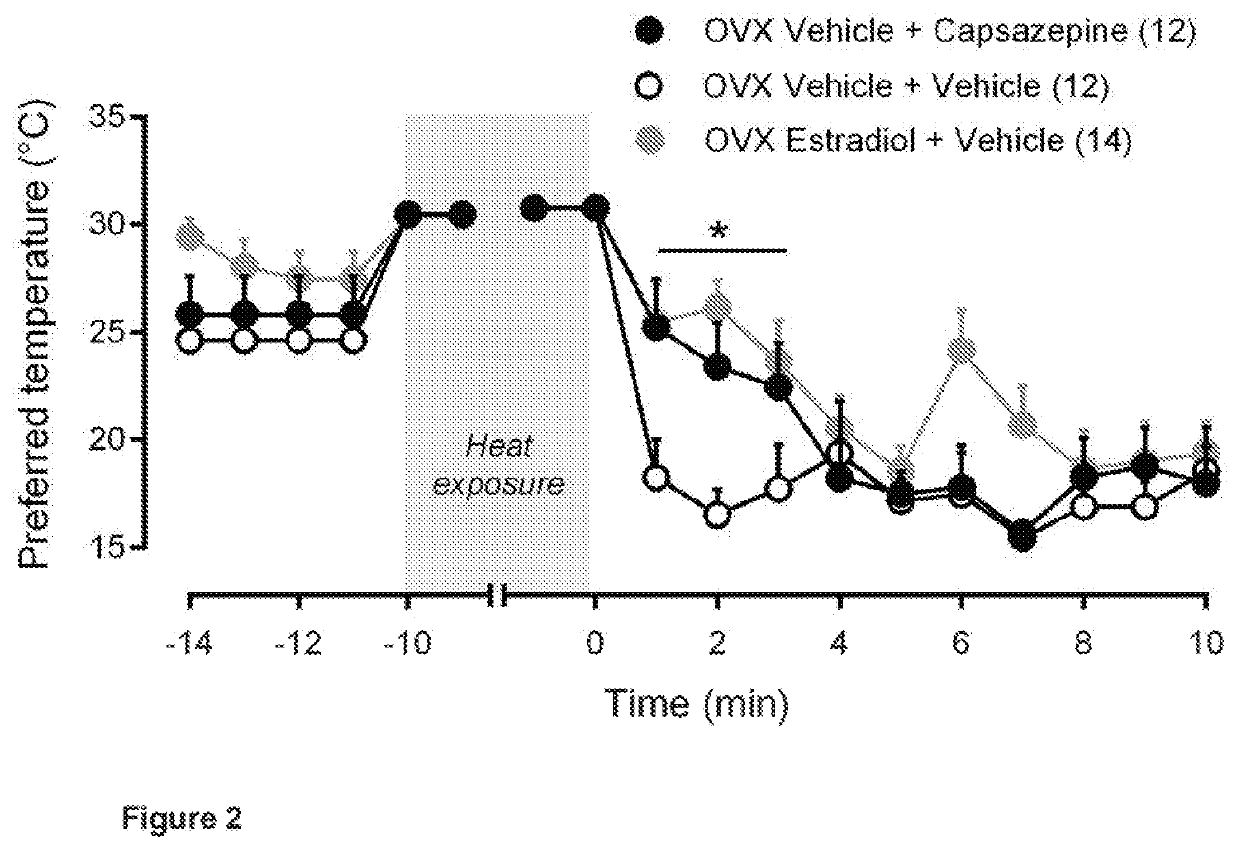Novel treatment for hot flushes
a hot flush and treatment technology, applied in the field of medical and biomedical, can solve the problems of hot flushes, estrogen therapy is not selective for hot flushes, has several dangerous side effects, and its development has been aborted
- Summary
- Abstract
- Description
- Claims
- Application Information
AI Technical Summary
Benefits of technology
Problems solved by technology
Method used
Image
Examples
example 1
Generally
[0065]Hot flushes (or hot flashes) constitute the most frequent complaint of postmenopausal women. There are no treatments for hot flushes other than the estrogen treatment, which treats the entire postmenopausal syndrome. Contrary to current beliefs, the inventors have disclosed that abnormal thermal discomfort is involved in this disorder.
[0066]Many TRPV1 antagonists have been synthesized and tested by multiple pharmaceutical companies as potential painkillers, but they have not been developed further due to the dangerous side effect—hyperthermia. The TRPV1 antagonist compounds that do not cause hyperthermia have reduced analgesic efficacy, as they do not block the proton mode of TRPV1 activation. Hence for inflammatory pain, these compounds would not work. In one embodiment, the inventors have disclosed that they do, however, block the heat mode. As such, TRPV1 antagonists are potential drugs to treat the abnormal heat discomfort, which takes place in hot flushes. Many s...
example 2
The TRPV1 Antagonists “Paradox”—Further Explained
[0068]As noted above and known to those of skill in the art, those TRPV1 antagonists that potently block the proton mode of activation of the TRPV1 channel (most antagonists), cause hyperthermia. Because hyperthermia by itself is likely to provoke hot flushes, these antagonists have not been the preferred compounds of choice. However, in accordance with various embodiments herein, one may still be able use them if one can decrease or prevent the hyperthermic effect (e.g., by desensitization), or for example, by administering them in such a way that they do not cause hyperthermia (e.g., applying them topically to the skin), or for example, if their desired thermal discomfort-preventing effect compensates for the adverse hyperthermic effect. These antagonists could be referred to herein as “group A.”
[0069]Further, those antagonists that do not cause hyperthermia (they do not affect the protons mode of activation) can still be effective ...
example 3
Experiments
[0072]Hot flushes are currently viewed as a normal reaction of abnormal(readily occurring) skin vasodilation. However, similar vasodilation often develops in non-estrogen-deficient individuals, both men and women, under many circumstances, such as, in a warm environment, after cold exposure, after eating spicy food, during heavy lifting, during sexual intercourse, when a person is ashamed or angry, and myriad other conditions. In some embodiments, the unpleasant general feeling of being hot (thermal discomfort) may be associated with hot flushes.
[0073]Thermal sensations are mediated by Thermo-TRP channels. There are six main warmth-sensitive channels in the skin and neurons that innervate the skin: TRPV1, TRPV2, TRPV3, and TRPV4, TRPM2, and TRPM3. TRPV1 channel is abundant on pain fibers and has a temperature threshold around 41° C. in vitro, but there is strong evidence that in vivo the threshold is lower, and that many biologically active substances can affect this thre...
PUM
| Property | Measurement | Unit |
|---|---|---|
| Thermal properties | aaaaa | aaaaa |
Abstract
Description
Claims
Application Information
 Login to View More
Login to View More - R&D
- Intellectual Property
- Life Sciences
- Materials
- Tech Scout
- Unparalleled Data Quality
- Higher Quality Content
- 60% Fewer Hallucinations
Browse by: Latest US Patents, China's latest patents, Technical Efficacy Thesaurus, Application Domain, Technology Topic, Popular Technical Reports.
© 2025 PatSnap. All rights reserved.Legal|Privacy policy|Modern Slavery Act Transparency Statement|Sitemap|About US| Contact US: help@patsnap.com



